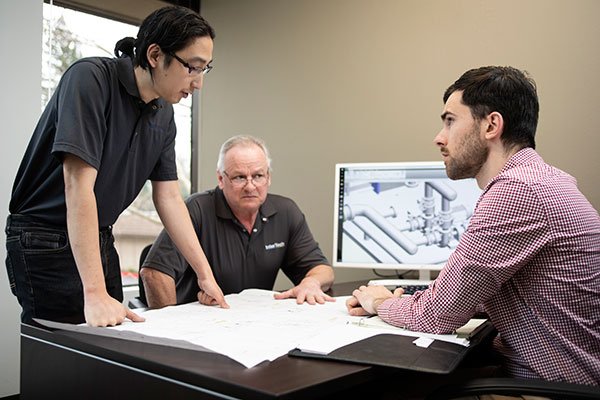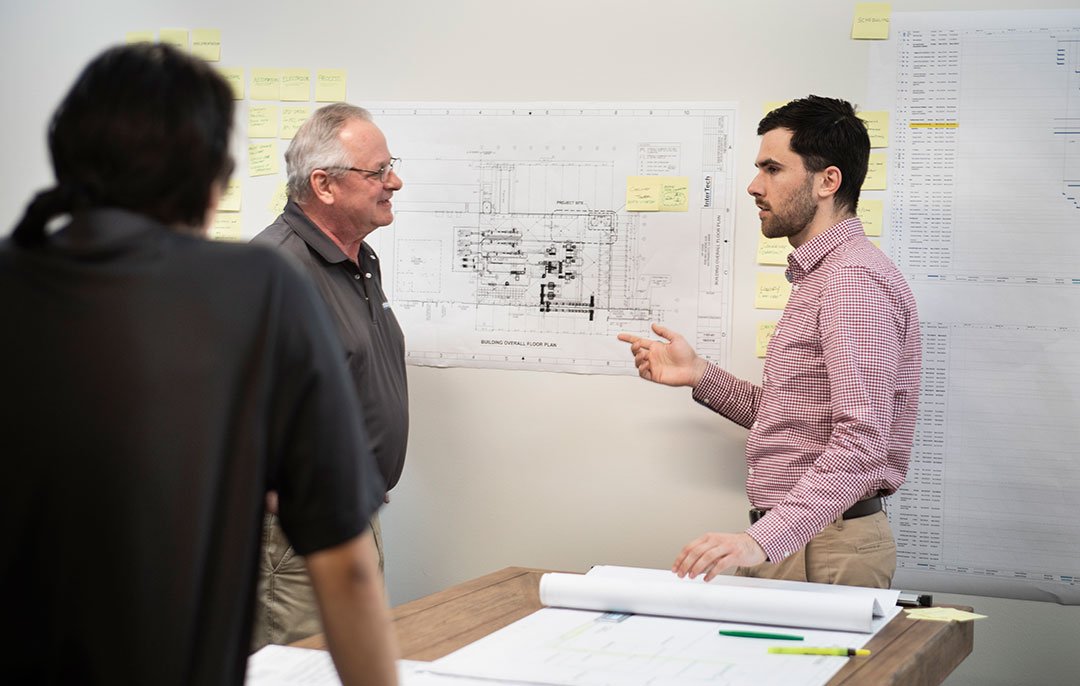Recently we published “How Pasteurizers Convert Raw Products into Safe Shelf-Stable Products.” In that article, you’ll gain an understanding about how your pasteurizer works and the key control factors. Think of this article as a part two. Here we will discuss three commonly found pasteurizer problems in the food and beverage industry.
Understanding these problems can empower you and point you in the right direction as challenges arise. In addition, you are welcome to contact us here at InterTech if you need assistance. We are always here to help.
1. Cracks, Crevices and Other Bad Piping Geometries Can Cause Pasteurizer Problems
The first on our list of pasteurizer problems is a big one. Let’s get right into it. A hold tube in its simplest form is a length of pipe with temperature sensors at either end. Inserting these sensors into the hold tube may seem easy, but many common sensor styles such as NPT threaded connections form crevices between the seal and the pipe wall.
Crevices harbor pathogens that clean-in-place (CIP) systems cannot effectively clean and sanitize. The correct approach is to use a sanitary connection where the temperature probe passes through a plate and is attached with a sanitary clamp connection.
However, installing a clamp connection alone does not guarantee a sanitary sensor connection. Connections that are greater than 1.5x the diameter of the pipe connection create dead legs. The scrubbing action associated with CIP flow does not circulate effectively in these types of openings.
Clients usually contact us when swabbing results show that the pasteurizer is not getting cleaned. This temperature probe connection is just one finding. There are pasteurizer problems that come from other piping geometries found in the field.
These include:
Low Point Drainage – There are two variations of this issue. The first variation usually happens when a pasteurizer is relocated and connecting pipes are field-fitted to reestablish the inlet and outlet connections.
During the relocation process, the orientation and elevation of the pasteurizer equipment can change to fit into its new area. This usually results with a contractor installing piping in such a way that a low spot is created.
The second variation happens when existing equipment is low (with a local drain valve), and the automation programs do not include all the required drain events. Low point drainage is critical because liquid slugs left inside the pasteurizer are sources of contamination.
Local High Points and Aeration – Good hold tube designs use piping geometries that are constantly ascending from the inlet to the discharge. Other less consistent hold tube geometries sometime include local high points between the hold tube inlet and outlet.
If liquid is not properly aerated prior to the hold tube, it will contain higher levels of entrained air that can come out of the solution as the liquid travels through the closed pasteurizer system. Trapped air migrates to local high points and sits, disrupting normal flow and causing unexpected heating and cleaning issues.
Local high points also cause other pasteurizer problems by complicating hold tube draining, valve configurations and automation programming.
Consider a local high point that looks like a hump filled with liquid on the up and down side of the hump. Under constant flow conditions, liquid moves from the up side of the hump to the down side.
When the pump turns off, liquid that is not yet commercially sterile on the up side of the hump flows backwards as it should. The unsterile liquid on the down side of the hump flows forward. Forward flow is not a good design practice in the hold tubes, and it can cause pasteurizer problems.
A local drain valve has to be installed and opened to let the liquid out during these events. Otherwise, liquid is left in the pasteurizer. It can create voids that either fill with air or become a local negative pressure zone.
This can lead to further contamination problems, and it may cause other issues with water hammer, cleaning and physical damage from transient dynamic forces related to flow.
Improper or No Pipe Slope – Pipe slope is another area where we often find pasteurizer problems. Mostly, it is the lack of slope that causes problems.
In pasteurizers, the entire hold tube including any piping leading up to and away from the tube should be sloped upward so unsterile product flows back towards the raw product side.
Most pasteurizers come with the appropriate piping. These issues are usually found in pipes that connect hold tube subassemblies to the heat exchanger and cooler unit.
Unsanitary Welds and Finishes – Any crevice, crack or pocket creates a home for pathogens because they cannot be easily cleaned and sterilized.
This problem is created by rough internal pipe walls and welds. Again, this problem appears more often in pasteurizers that have been relocated or modified.
When a new bottle is introduced to the packaging line, it is critical to audit your pasteurizer system to ensure it remains balanced with the line.
It is also important to ensure it continues to meet sanitary design principles laid out by the 3-A Sanitary Standards and the FDA approved Grade ”A” Pasteurized Milk Ordinance (PMO).
It is also good to audit your pasteurizer system whenever you introduce a new bottle to the packaging line, change existing bottle sizes, speed up or slow down the filler, or modify the pasteurizer parameters.
Remember, just because all components of the system are rated for sanitary use, it does not mean the system is sanitary.

2. Turbulence and Velocity in a Hold Tube Can Also Cause Problems
The second issue on our list of commonly found pasteurizer problems is turbulence and velocity in a hold tube. Engineers and scientists are susceptible to making oversimplifications. But, the study of turbulent flow is complex.
Many of the formulas used are developed to match observed conditions rather than developed using calculus. Formulas derived through calculus can be used for every occurrence.
A good example of an analytically derived formula (calculus) is a circle. There is one equation that defines all circles regardless of the diameter.
Fluid flow dynamics change depending on fluid properties. Turbulent flow collisions and momentum exchanges are primary forces. This changes for fluids located close to the wall and changes even more for fluids with higher viscosities.
In both cases, shear is a resistive force that reduces or cancels momentum forces.
Often fluid equations are derived empirically rather analytically. Meaning, many of the equations are derived from the observed outcomes of particular fluids. The application of fluid equations must include the consideration of the fluid conditions and physical properties.
The assumption of “perfectly turbulent flow” is dangerously tempting. This is because not all turbulent flow is created equal. Reynolds numbers greater than 4,000 are often considered “fully turbulent,” but this does not account for the boundary layer and “no slip” assumptions.
This contradiction is typically disregarded because the effect is too small to be meaningful. However, the precision with which hold tubes must operate does not allow these effects to be safely ignored. In pipe flow, work average velocity is generally used.
But, due to channeling, large and small eddies and different parts of the fluid pass through a length of pipe at different speeds and times. Maximum velocity passes fluid through a pipe faster than fluid traveling closer to the average velocity.
If every molecule needs to be sterilized and requires a specific time, designers need to consider what velocity will be used for the time and flow equations.
Given 100-feet of pipe and a hold time of 10-seconds the average velocity is 10ft/s, if the average velocity is 80% of the maximum velocity, then some of the fluid will travel through the same 100-feet of pipe in only 8-seconds.
If sterilization takes 10-seconds, some of the product running at the maximum velocity will not get sterilized.
3. Incorrect Drawings and Calculations Can Create Inconsistencies
Design and theory are useful tools, but ultimately they cannot match the power of empirical proof. Even when pasteurizer drawings and calculations are provided, they are oftentimes out of date or do not reflect current operating conditions. These inconsistencies can cause pasteurizer problems.
The good news is that there is a standard hold tube test that can provide hard data. It is called the salt test. The salt test uses water and salt.
A conductivity sensor and saline injection device is placed at the starting portion of the hold tube. A second conductivity sensor is placed at the other end of the hold tube. Water is then circulated in the tube at operating conditions.
Once flow is established, saline is pulsed into the tube. A controller begins a timer and the saline circulates through the hold tube. When it reaches the second conductivity sensor at the end of the tube, the timer stops, allowing the actual hold time to be measured.
The test is repeated many times. Time data must comply with critical parameters before the data can be used to verify the hold tube time and velocity. This is why salt testing is used by regulatory agencies to validate pasteurizer performance.
Reach out to InterTech today to schedule a check-up of your pasteurizer.

Let us show you how InterTech will improve your operating efficiencies and increase your profitability
InterTech brings clients value by performing plant engineering services with integrity, skill and efficiency. Our specialty is working within existing facilities to optimize line design for space and efficiency.


0 Comments